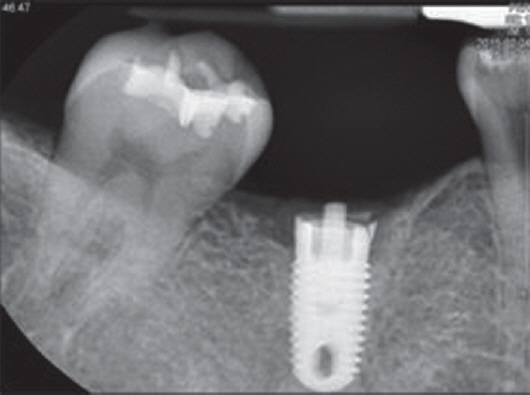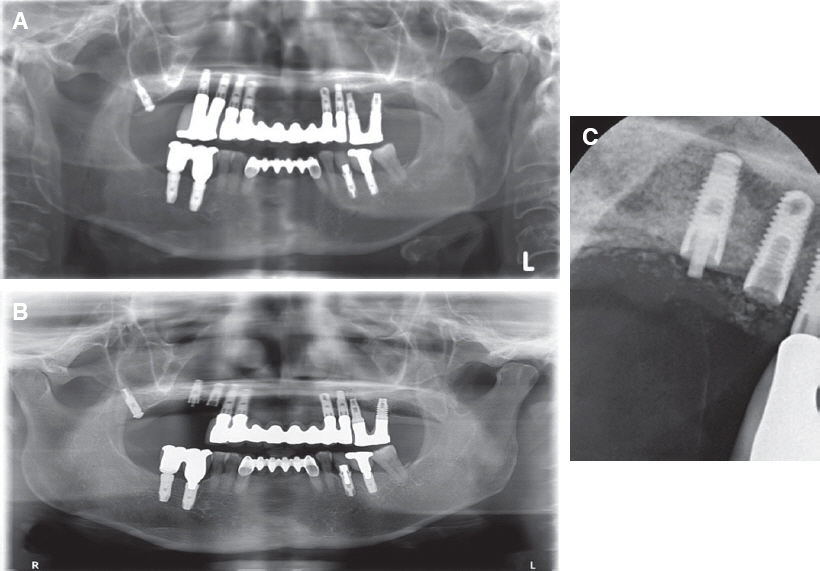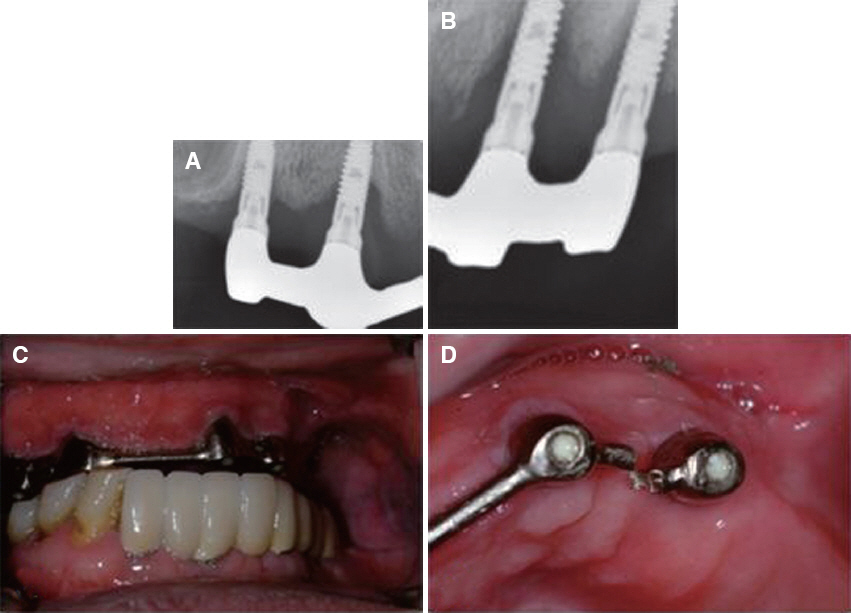J Dent Rehabil Appl Sci.
2015 Dec;31(4):349-357. 10.14368/jdras.2015.31.4.349.
Prosthodontic problems and complications associated with osseointegration
- Affiliations
-
- 1Department of Prosthodontics, College of Dentistry, Dankook University, Cheonan, Republic of Korea. syshin@dankook.ac.kr
- KMID: 2150199
- DOI: http://doi.org/10.14368/jdras.2015.31.4.349
Abstract
- Edentulous patients with a severely resorbed mandible or maxilla often experience problems with conventional dentures, such as insufficient stability and retention, together with a decrease in chewing ability. Because of the good prognosis of dental implants, these patients can be successfully treated with implant-retained or implant-supported prosthesis. Ideally, a maximum number of implants of maximum length are placed in appropriate surgically prepared sites that are surrounded by a maximum amount of bone of favorable quality. The implants are favorably aligned faciolingually and mesiodistally to enhance optimal prosthodontic design. This article describes the clinical problems and complications encountered when treating a consecutive number of edentulous patients with osseointegrated implant-supported prostheses.
MeSH Terms
Figure
Cited by 1 articles
-
The effect of heat to remove cement on implant titanium abutment and screw
Hyo-Gyoung Yi, Ki-Sung Gil, Jung-Jin Lee, Seung-Geun Ahn, Jae-Min Seo
J Korean Acad Prosthodont. 2018;56(3):179-187. doi: 10.4047/jkap.2018.56.3.179.
Reference
-
References
1. Adell R, Lekholm U, Rockler B, Brånemark PI. A 15-year study of osseointegrated implants in the treatment of the edentulous jaw. Int J Oral Surg. 1981; 10:387–416. DOI: 10.1016/S0300-9785(81)80077-4.2. Albrektsson T, Dahl E, Enbom L, Engevall S, Engquist B, Eriksson AR, Feldmann G, Freiberg N, Glantz PO, Kjellman O, Kristersson L, Kvint S, Kondell PA, Palmquist J, Werndahl L, Astrand P. Osseointegrated oral implants. A Swedish multicenter study of 8139 consecutively inserted Nobelpharma implants. J Periodontol. 1988; 59:287–96. DOI: 10.1902/jop.1988.59.5.287. PMID: 3290429.3. Albrektsson T. A multicenter report on osseointegrated oral implants. J Prosthet Dent. 1988; 60:75–84. DOI: 10.1016/0022-3913(88)90355-1.4. Johansson G, Palmqvist S. Complications, supplementary treatment, and maintenance in edentulous arches with implant-supported fixed prostheses. Int J Prosthodont. 1990; 3:89–92. PMID: 2196896.5. Lindquist LW, Rockler B, Carlsson GE. Bone resorption around fixtures in edentulous patients treated with mandibular fixed tissue-integrated prostheses. J Prosthet Dent. 1988; 59:59–63. DOI: 10.1016/0022-3913(88)90109-6.6. Ogiso M, Tabata T, Kuo PT, Borgese D. A histologic comparison of the functional loading capacity of an occluded dense apatite implant and the natural dentition. J Prosthet Dent. 1994; 71:581–8. DOI: 10.1016/0022-3913(94)90441-3.7. Isidor F. Loss of osseointegration caused by occlusal load of oral implants. A clinical and radiographic study in monkeys. Clin Oral Implants Res. 1996; 7:143–52. DOI: 10.1034/j.1600-0501.1996.070208.x. PMID: 9002833.8. Isidor F. Histologic evaluation of peri-implant bone at implants subjected to occlusal overload or plaque accumulation. Clin Oral Implants Res. 1997; 8:1–9. DOI: 10.1111/j.1600-0501.1997.tb00001.x. PMID: 9586450.9. Jemt T, Book K. Prosthesis misfit and marginal bone loss in edentulous implant patients. Int J Oral Maxillofac Implants. 1996; 11:620–5. PMID: 8908860.10. Naert I, Quirynen M, van Steenberghe D, Darius P. A study of 589 consecutive implants supporting complete fixed prostheses. Part II:prosthetic aspects. J Prosthet Dent. 1992; 68:949–56. DOI: 10.1016/0022-3913(92)90557-Q.11. Adell R, Eriksson B, Lekholm U, Brånemark PI, Jemt T. Long-term followup study of osseointegrated implants in the treatment of totally edentulous jaws. Int J Oral Maxillofac Implants. 1990; 5:347–59. PMID: 2094653.12. Tolman DE, Laney WR. Tissue-integrated prosthesis complications. Int J Oral Maxillofac Implants. 1992; 7:477–84. PMID: 1299643.13. Rangert B, Krogh PH, Langer B, Van Roekel N. Bending overload and implant fracture:a retrospective clinical analysis. Int J Oral Maxillofac Implants. 1995; 10:326–34. PMID: 7615329.14. Zarb GA, Schmitt A. The longitudinal clinical effectiveness of osseointegrated dental implants:the Toronto study. Part III:problems and complications encountered. J Prosthet Dent. 1990; 64:185–94. DOI: 10.1016/0022-3913(90)90177-E.15. Walton JN, MacEntee MI. Problems with prostheses on implants:a retrospective study. J Prosthet Dent. 1994; 71:283–8. DOI: 10.1016/0022-3913(94)90468-5.16. Worthington P, Bolender CL, Taylor TD. The Swedish system of osseointegrated implants:problems and complications encountered during a 4-year trial period. Int J Oral Maxillofac Implants. 1987; 2:77–84. PMID: 3325415.17. Cox JF, Zarb GA. The longitudinal clinical efficacy of osseointegrated dental implants:a 3-year report. Int J Oral Maxillofac Implants. 1987; 2:91–100. PMID: 3325416.18. Jemt T. Failures and complications in 391 consecutively inserted fixed prostheses supported by Brånemark implants in edentulous jaws:a study of treatment from the time of prosthesis placement to the first annual checkup. Int J Oral Maxillofac Implants. 1991; 6:270–6. PMID: 1813395.19. Kallus T, Bessing C. Loose gold screws frequently occur in full-arch fixed prostheses supported by osseointegrated implants after 5 years. Int J Oral Maxillofac Implants. 1994; 9:169–78. PMID: 8206552.20. Binon PP. Implants and components:entering the new millennium. Int J Oral Maxillofac Implants. 2000; 15:76–94. PMID: 10697942.21. Brunski JB, Puleo DA, Nanci A. Biomaterials and biomechanics of oral and maxillofacial implants:current status and future developments. Int J Oral Maxillofac Implants. 2000; 15:15–46. PMID: 10697938.22. Sones AD. Complications with osseointegrated implants. J Prosthet Dent. 1989; 62:581–585. DOI: 10.1016/0022-3913(89)90084-X.
- Full Text Links
- Actions
-
Cited
- CITED
-
- Close
- Share
- Similar articles
-
- Analysis of prosthodontic and surgical treatment of acquired palatal defect after maxillectomy
- Influence of implant misplacement on the success of the final prosthesis: Subjective evaluation by a prosthodontist of dental implants placed by an oral and maxillofacial surgeon
- Clinical retrospective study of sinus bone graft and implant placement
- Finite element approach to investigate the influence of the design configuration of the ITI solid implant on the bone stresses during the osseointegration process
- The study of awareness and practice of infection control on dental practitioners during the prosthodontic treatment










